Sensory Evaluation and Oxidative Stability of a Suncream Formulated with Thermal Spring Waters from Ourense (NW Spain) and Sargassum muticum Extracts
Abstract
:1. Introduction
2. Results and Discussion
2.1. Chemical Characteristics of the Thermal Spring Water
2.2. Visual Influence of the Extracts in the Cosmetic Formulations
2.3. The pH of the Suncreams
2.4. Sensory Analysis
2.5. CIELab Color Space Parameters
2.6. Oxidation During Storage
3. Materials and Methods
3.1. Materials
3.1.1. Water
3.1.2. Extracts
3.2. Methods
3.2.1. Suncream Formula
3.2.2. Analytical Methods
Determination of the Water Composition
Emulsion pH and Color Determination
Sensory Analysis
Oxidation Experiments
Statistical Analysis
4. Conclusions
Acknowledgments
Author Contributions
Conflicts of Interest
References
- Conti, V.; Corbi, G.; Simeon, V.; Russomanno, G.; Manzo, V.; Ferrara, N.; Filippelli, A. Aging-related changes in oxidative stress response of human endothelial cells. Aging Clin. Exp. Res. 2015, 27, 547–553. [Google Scholar] [CrossRef] [PubMed]
- Pillai, S.; Oresajo, C.; Hayward, J. Ultraviolet radiation and skin aging: Roles of reactive oxygen species, inflammation and protease activation, and strategies for prevention of inflammation-induced matrix degradation—A review. Int. J. Cosmet. Sci. 2005, 27, 17–34. [Google Scholar] [CrossRef] [PubMed]
- Herrling, T.; Jung, K. The Radical Status Factor (RSF): A novel metric to characterize skin products. Int. J. Cosmet. Sci. 2012, 34, 285–290. [Google Scholar] [CrossRef] [PubMed]
- Jorge, A.T.S.; Arroteia, K.F.; Lago, J.C.; De Sá-Rocha, V.M.; Gesztesi, J.; Moreira, P.L. A new potent natural antioxidant mixture provides global protection against oxidative skin cell damage. Int. J. Cosmet. Sci. 2011, 33, 113–119. [Google Scholar] [CrossRef] [PubMed]
- Silva, A.R.; Menezes, P.F.C.; Martinello, T.; Novakovich, G.F.L.; Praes, C.E.; Feferman, I.H. Antioxidant kinetics of plant-derived substances and extracts. Int. J. Cosmet. Sci. 2010, 32, 73–80. [Google Scholar] [CrossRef] [PubMed]
- Silva, A.R.; Seidl, C.; Furusho, A.S.; Boeno, M.M.S.; Dieamant, G.C.; Weffort-Santos, A.M. In vitro evaluation of the efficacy of commercial green tea extracts in UV protection. Int. J. Cosmet. Sci. 2013, 35, 69–77. [Google Scholar] [CrossRef] [PubMed]
- Saraf, S.; Kaur, C. Phytoconstituents as photoprotective novel cosmetic formulations. Pharmacogn. Rev. 2010, 4, 1–11. [Google Scholar] [CrossRef] [PubMed]
- Di Mambro, V.M.; Fonseca, M.J.V. Assays of physical stability and antioxidant activity of a topical formulation added with different plant extracts. J. Pharm. Biomed. Anal. 2005, 37, 287–295. [Google Scholar] [CrossRef] [PubMed]
- Balboa, E.M.; Moure, A.; Domínguez, H. Valorization of Sargassum muticum biomass according to the biorefinery concept. Mar. Drugs 2015, 13, 3745–3760. [Google Scholar] [CrossRef] [PubMed]
- Balboa, E.M.; Soto, M.L.; Nogueira, D.R.; González-López, N.; Conde, E.; Moure, A.; Vinardell, M.P.; Mitjans, M.; Domínguez, H. Potential of antioxidant extracts produced by aqueous processing of renewable resources for the formulation of cosmetics. Ind. Crop. Prod. 2014, 58, 104–110. [Google Scholar] [CrossRef]
- Balboa, E.M.; Li, Y.X.; Ahn, B.N.; Eom, S.H.; Domínguez, H.; Jiménez, C.; Rodríguez, J. Photodamage attenuation effect by a tetraprenyltoluquinol chromane meroterpenoid isolated from Sargassum muticum. J. Photochem. Photobiol. B 2015, 148, 51–58. [Google Scholar] [CrossRef] [PubMed]
- Nunes, S.; Tamura, B.M. A historical review of mineral water. Surg. Cosmet. Dermatol. 2012, 4, 252–258. [Google Scholar]
- Seite, S. Thermal waters as cosmeceuticals: La Roche-Posay thermal spring water example. Clin. Cosmet. Investig. Dermatol. 2013, 6, 23–28. [Google Scholar] [CrossRef] [PubMed]
- Ghersetich, I.; Brazzini, B.; Hercogova, J.; Lotti, T.M. Mineral waters: Instead of cosmetics or better than cosmetics? Clin. Dermatol. 2001, 19, 478–482. [Google Scholar] [CrossRef]
- Matz, H.; Orion, E.; Wolf, R. Balneotherapy in dermatology. Dermatol. Ther. 2003, 16, 132–140. [Google Scholar] [CrossRef] [PubMed]
- Nappi, G.; De Luca, S.; Magrassi, P.; Benedetti, S.; Cocchi, M.; Mattina, R. Effects of oral administration of the “LETE” mineral water on Reactive Oxygen Metabolites (ROM) and on Biological Antioxidant Potential (BAP). Prog. Nutr. 2011, 13, 91–98. [Google Scholar]
- Oláh, M.; Koncz, Á.; Fehér, J.; Kálmánczhey, J.; Olah, C.; Nagy, G.; Bender, T. The effect of balneotherapy on antioxidant, inflammatory, and metabolic indices in patients with cardiovascular risk factors (hypertension and obesity)-A randomised, controlled, follow-up study. Contemp. Clin. Trials 2011, 32, 793–801. [Google Scholar] [CrossRef] [PubMed]
- Delgado-Outeiriño, I.; Araújo-Nespereira, P.; Cid-Fernández, J.A.; Mejuto, J.C.; Martínez-Carballo, E.; Simal-Gándara, J. Behaviour of thermal waters through granite rocks based on residence time and inorganic pattern. J. Hydrol. 2009, 373, 329–336. [Google Scholar] [CrossRef]
- Gomes, C.D.S.F. Naturotherapies based on minerals. Geomaterials 2013, 3, 1–14. [Google Scholar] [CrossRef]
- Braga, P.C.; Dal Sasso, M.; Culici, M.; Spallino, A.; Marabini, L.; Bianchi, T.; Nappi, G. Effects of sulphurous water on human neutrophil elastase release. Ther. Adv. Respir. Dis. 2010, 4, 333–340. [Google Scholar] [CrossRef] [PubMed]
- Guillén, M.D.; Cabo, N. Fourier transform infrared spectra data versus peroxide and anisidine values to determine oxidative stability of edible oils. Food Chem. 2002, 77, 503–510. [Google Scholar] [CrossRef]
- UNE-EN ISO 8587:2010. Sensory Analysis. Methodology. Ranking. In Análisis Sensorial, 2nd ed.; AENOR: Madrid, Spain, 2010; p. 239. Available online: http://www.en.aenor.es/aenor/normas/normas/fichanorma.asp?tipo=N&codigo=N0045392 (accessed on 2 May 2017).
- Díaz, M.; Dunn, C.M.; McClements, J.; Decker, E.A. Use of caseinophospho-peptides as natural antioxidants in oil-in-water emulsions. J. Agric. Food Chem. 2003, 51, 2365–2370. [Google Scholar] [CrossRef] [PubMed]
- AOCS Official Method Cd 18-90. In Official Methods and Recommended Practices of the American Oil Chemists’ Society (AOCS), 4th ed.; Firestone, D. (Ed.) American Oil Chemists’ Society: Champaign, IL, USA, 1989. [Google Scholar]
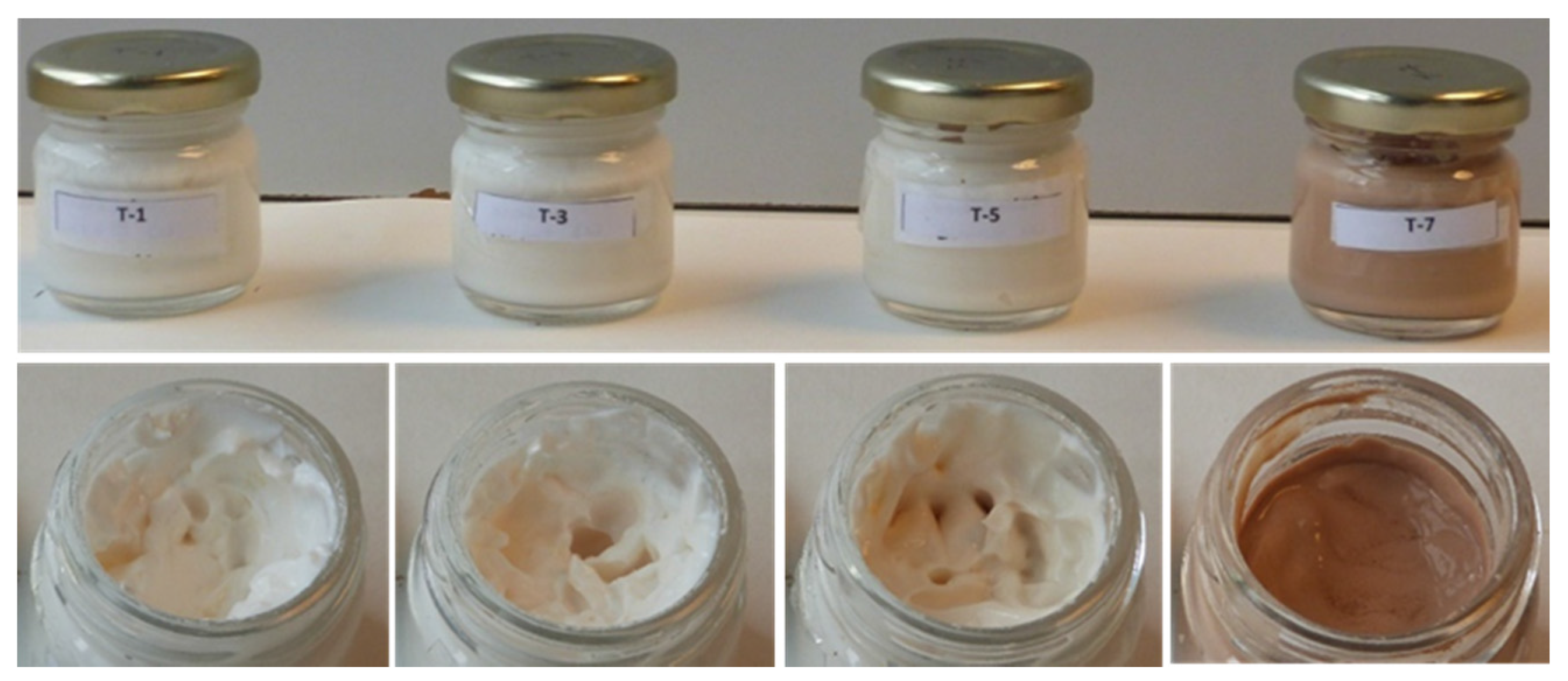
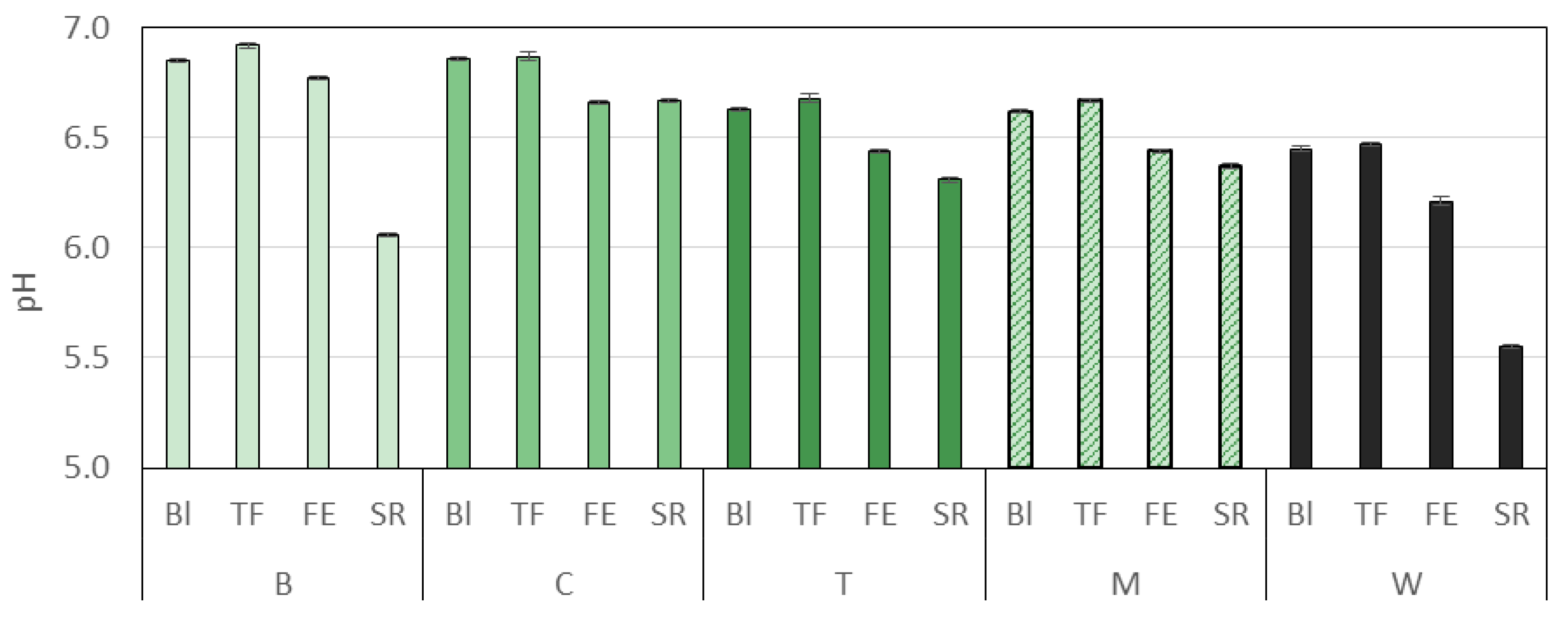
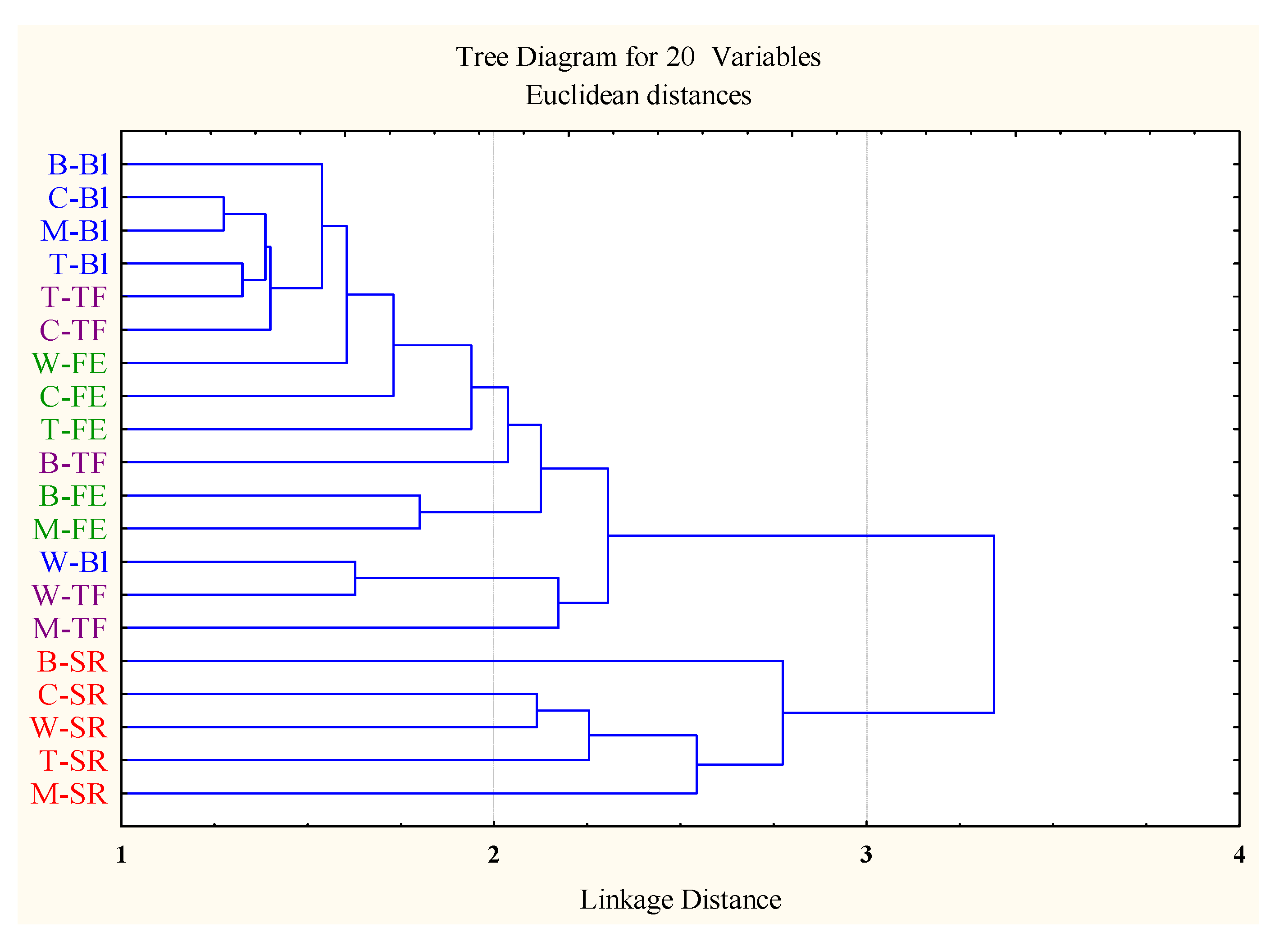
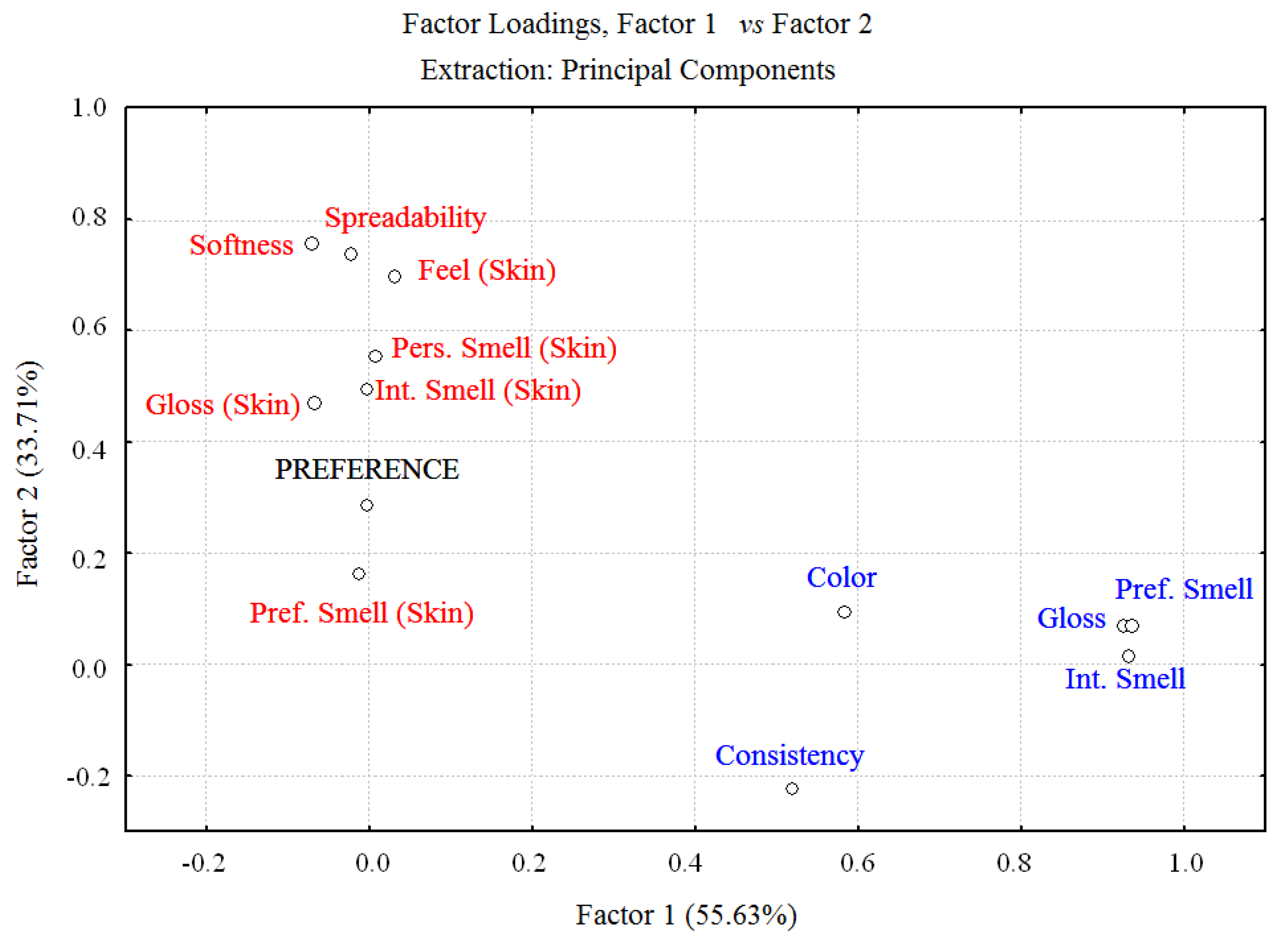


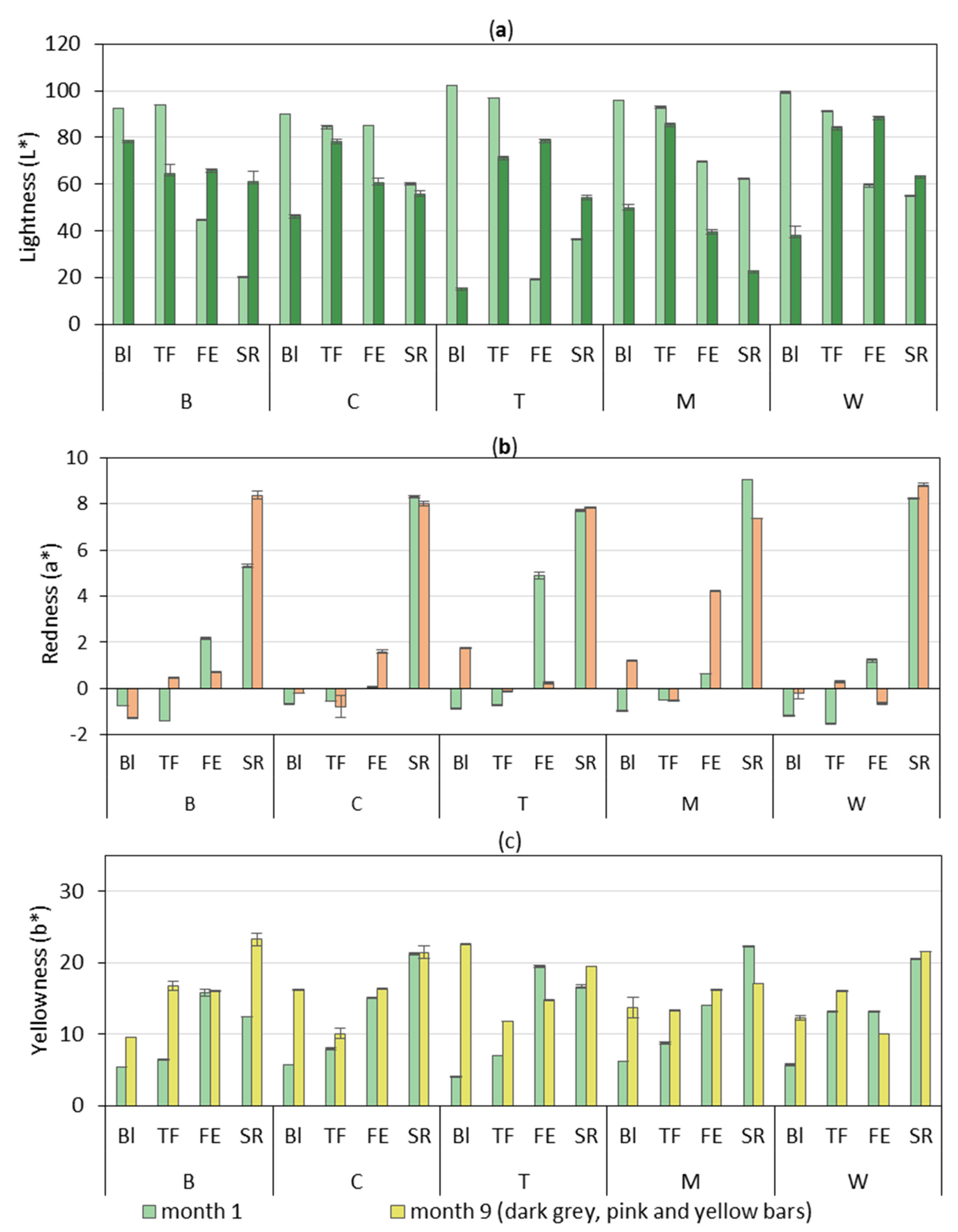

| Thermal Spring Water Source | Code | pH | F− | Cl− | NO2− | NO3− | SO42− | S2− | K+ | Ca2+ | Na+ | Mg2+ | Fe2+ |
|---|---|---|---|---|---|---|---|---|---|---|---|---|---|
| As Burgas | B | 7.41 | 14 | 20 | <0.1 | <0.1 | 3 | 0.02 | 8.2 | 11 | 102 | 0.69 | 0.01 |
| A Chavasqueira | C | - | 14 | 18 | <0.1 | 3 | 10 | 0.06 | 4.0 | 6.1 | 127 | 0.30 | 0.10 |
| O Tinteiro | T | 7.96 | 14 | 12 | <0.1 | <0.1 | 14 | 14 | 3.0 | 2.0 | 101 | 1.0 | 0.02 |
| O Muíño da Veiga | M | 8.52 | 12 | 13 | <0.1 | <0.1 | 6 | - | 4.0 | 2.0 | 103 | 1.0 | 0.03 |
| Bidistilled mQ water | W | 6.6 | - | - | - | - | - | - | - | - | - | - | - |
© 2017 by the authors. Licensee MDPI, Basel, Switzerland. This article is an open access article distributed under the terms and conditions of the Creative Commons Attribution (CC BY) license (http://creativecommons.org/licenses/by/4.0/).
Share and Cite
Balboa, E.; Conde, E.; Constenla, A.; Falqué, E.; Domínguez, H. Sensory Evaluation and Oxidative Stability of a Suncream Formulated with Thermal Spring Waters from Ourense (NW Spain) and Sargassum muticum Extracts. Cosmetics 2017, 4, 19. https://doi.org/10.3390/cosmetics4020019
Balboa E, Conde E, Constenla A, Falqué E, Domínguez H. Sensory Evaluation and Oxidative Stability of a Suncream Formulated with Thermal Spring Waters from Ourense (NW Spain) and Sargassum muticum Extracts. Cosmetics. 2017; 4(2):19. https://doi.org/10.3390/cosmetics4020019
Chicago/Turabian StyleBalboa, Elena, Enma Conde, Astrid Constenla, Elena Falqué, and Herminia Domínguez. 2017. "Sensory Evaluation and Oxidative Stability of a Suncream Formulated with Thermal Spring Waters from Ourense (NW Spain) and Sargassum muticum Extracts" Cosmetics 4, no. 2: 19. https://doi.org/10.3390/cosmetics4020019






